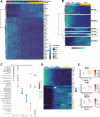Transcriptional landscapes underlying Notch-induced lineage conversion and plasticity of mammary basal cells
- PMID: 40186028
- PMCID: PMC12084385
- DOI: 10.1038/s44318-025-00424-1
Transcriptional landscapes underlying Notch-induced lineage conversion and plasticity of mammary basal cells
Abstract
The mammary epithelium derives from multipotent mammary stem cells (MaSCs) that engage into differentiation during embryonic development. However, adult MaSCs maintain the ability to reactivate multipotency in non-physiological contexts. We previously reported that Notch1 activation in committed basal cells triggers a basal-to-luminal cell fate switch in the mouse mammary gland. Here, we report conservation of this mechanism and found that in addition to the mammary gland, constitutive Notch1 signaling induces a basal-to-luminal cell fate switch in adult cells of the lacrimal gland, the salivary gland, and the prostate. Since the lineage transition is progressive in time, we performed single-cell transcriptomic analysis on index-sorted mammary cells at different stages of lineage conversion, generating a temporal map of changes in cell identity. Combining single-cell analyses with organoid assays, we demonstrate that cell proliferation is indispensable for this lineage conversion. We also reveal the individual transcriptional landscapes underlying the cellular plasticity switching of committed mammary cells in vivo with spatial and temporal resolution. Given the roles of Notch signaling in cancer, these results may help to better understand the mechanisms that drive cellular transformation.
Keywords: Epithelial Stem Cells; Lineage Conversion; Notch1 Signaling; Plasticity.
© 2025. The Author(s).
Conflict of interest statement
Disclosure and competing interests statement. The authors declare no competing interests.
Figures











References
-
- Afshar-Sterle S, Carli ALE, O’Keefe R, Tse J, Fischer S, Azimpour AI, Baloyan D, Elias L, Thilakasiri P, Patel O et al (2024) DCLK1 induces a pro-tumorigenic phenotype to drive gastric cancer progression. Science Signaling 17:eabq4888 - PubMed
-
- Allan GJ, Beattie J, Flint DJ (2004) The role of IGFBP-5 in mammary gland development and involution. Domest Anim Endocrinol 27:257–266 - PubMed
MeSH terms
Substances
Grants and funding
- ARCPDF12021020003033)/Fondation ARC pour la Recherche sur le Cancer (ARC)
- C19-64-2019-228/Université de Recherche Paris Sciences et Lettres (PSL)
- ARCPGA2021120004232_4874/Fondation ARC pour la Recherche sur le Cancer (ARC)
- FSER20200211117/Fondation Schlumberger pour l'Education et la Recherche (FSER)
- 11-LBX-0044/Agence Nationale de la Recherche (ANR)
- 24-0216/Worldwide Cancer Research (WCR)
- ANR-21-CE13-0047/Agence Nationale de la Recherche (ANR)
- EQU201903007821/Fondation pour la Recherche Médicale (FRM)
- ANR-22-CE13-0009/Agence Nationale de la Recherche (ANR)
- 950349/EC | ERC | HORIZON EUROPE European Research Council (ERC)
- WT_/Wellcome Trust/United Kingdom
LinkOut - more resources
Full Text Sources

